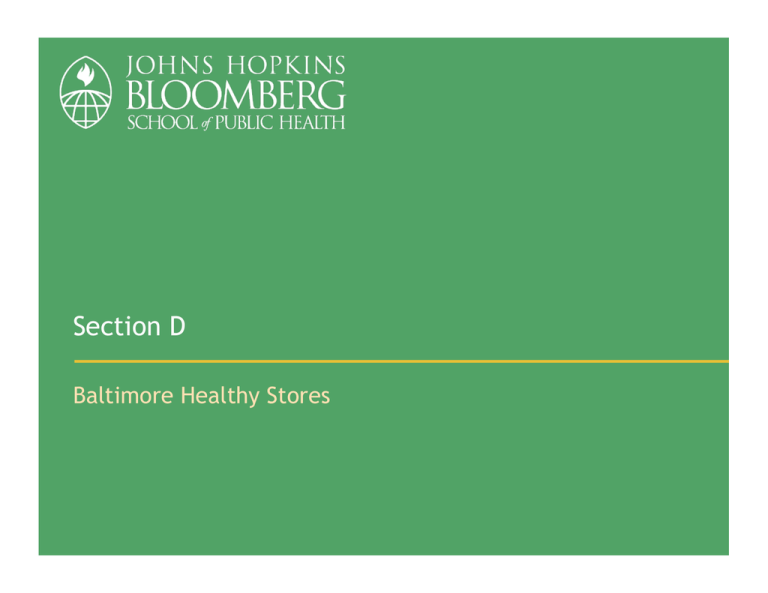Section D Baltimore Healthy Stores
advertisement

Section D Baltimore Healthy Stores Baltimore Healthy Stores Goals To increase availability and access to healthy foods for residents of Baltimore City To promote these foods at the point of purchase To work in collaboration with community agencies, the city of Baltimore, and local food sources 2 Healthy Foods Availability in Baltimore City* Type of food stores Healthy food availability index, mean (range 0–27) Skim milk (%) Fruit (%) 1–25 ≥26 Vegetables (%) 1–25 ≥26 Whole wheat bread (%) Supermarkets (16) 19.0 100 25 69 13 81 100 Grocery/corner stores (107) 4.4 25 43 3 57 3 8 “Behind-theglass” stores (20) 2.0 0 0 0 0 0 0 Convenience stores (33) 3.8 36 33 0 21 0 24 *Franco data, n = 176 3 A Corner Store 4 Store Interior 5 Baltimore Healthy Stores, Round 1 East Baltimore: intervention area West Baltimore: comparison area Store sample - Two supermarkets per area - Six to seven small stores per area Consumer sample - Eighty-seven respondents per area 6 Top Sources of Energy, Fat, and Sugar (Baltimore City) Top ten sources of energy, fat, and sugar of inner city adult respondents in Baltimore (Sharma et al.) Energy Food item Fat Energy (%) Food item Sugar Fat (%) Food item Sugar (%) Sodas 9.5 Chicken 12.1 Sodas 34.1 Chicken 8.2 Hot dogs, sausages 8.1 Sugary drinks (iced tea, punch) 15.2 Breads 6.0 Chips 6.3 Juices 9.0 Cake, donut and other pastry 4.2 Meat dishes 5.2 Sugar and syrup 8.3 Sandwiches and burgers 4.0 Margarine and butter 5.2 Cake, pastry and donut 4.2 Sugary drinks 3.8 Cake, donut and other pastry 5.1 Candies 4.1 Chips 3.7 Mayo, salad dressing, dips 4.9 Ice cream 3.2 Pasta dishes 3.3 Sandwiches and burgers 4.5 Cookies 2.5 Meat dishes 3.1 Cheese 4.3 Fruits 2.1 Candies 2.9 Eggs 4.0 Cereals 1.6 Total 48.7 Total 59.8 Total 84.3 7 Baltimore Healthy Stores Phases Phase 0: Teasers/Recruitment Phase 1: Healthy Eating for your Kids Phase 2: Cooking at Home Phase 3: Healthy Snacks Phase 4: Carryout Foods Phase 5: Low-Calorie Drinks 8 Intervention Activities Stop, Shop, Save Phase 2: Healthy Breakfast 9 Phase 0: Documents for Store Owners Cultural guidelines for Korean store owners 10 Phase 1: Low-Calorie Beverages Flyer Educational display Coupon 11 Phase 2: Healthy Breakfast Flyer Educational display 12 Phase 3: Cooking at Home Posters 13 Phase 4: Healthy Carryout Educational display Flyer 14 Phase 5: Healthy Snacks Posters 15 BHS Evaluation Plan Instrument Pre- Mid- Post- Followup x x Process evaluation Store process evaluation Store owner process evaluation Cooking demo, taste test evaluation Cooking demo, taste test customer evaluation Weekly interventionist progress report x x x x x Store impact and feasibility Store impact questionnaire Bi-weekly food sales (corner) In-depth interviews x x x x x x Customer impact and feasibility Customer impact questionnaire Food frequency questionnaire Customer feasibility interviews x x x x x x 16 Store Results Average stocking/sales feasibility scores at baseline, post-phase, and post-intervention Average stocking feasibility scores (Score range 0–10) Average sales feasibility score (Score range 0–10) Intervention Comparison Significance Intervention Comparison Significance Baseline 5.9 ± 2.0 6.8 ± 1.6 NS 4.4 ± 1.8 5 ± 1.5 NS Post-phase 8.3 ± 1.0 6 ± 1.8 0.004 7.1 ± 2.0 5.8 ± 1.8 0.05 Postintervention 7 ± 2.0 5.5 ± 1.5 0.009 6.4 ± 1.8 4.7 ± 1.5 0.003 17 Consumer Results After adjustment for baseline value, age, sex, and SES - Significant impact on food preparation methods and frequency of purchase of promoted foods - Trend of impact on food intentions 18 Eight Total Programs 19 Healthy Stores Studies Summary Intervention components Program Marshall Islands Healthy Stores Apache Healthy Stores 1,2 Zhiiwaapenewin Akino’maagewin Basic store activities Other store activities X Consumer psychosocial factors Consumer behavior Store Knowledge Healthy food purchasing N/A X X (Commodity, vendors rd 2) Knowledge Healthy food purchasing and consumption Increased stocking and sales X X (Schools, HSS) Knowledge (assoc. w/ exposure) Healthy food purchasing N/A X (CAC, churches) Intentions Healthy cooking methods, purchasing labeled foods Increased stocking and sales Media Other venues X X X Impact observed Baltimore Healthy Stores 1,2 X Healthy Foods Hawaii X X X (Producers, distributors) ? ? ? Healthy Foods North (Arctic) X X X (Worksites, HSS) ? ? ? Navajo Healthy Stores X ? ? ? X X X 20 Future Directions Baltimore Healthy Stores - Baltimore Healthy Eating Zones (youth) - Baltimore Healthy Church Zones (adult churchgoers) Zhiiwaapenewin Akino’maagewin - Proposed expanded trial under review by USDA/NRI Navajo Healthy Stores - Producer formative research - Farms to Table program 21 Acknowledgments Collaborators - Jean Anliker, U Mass - Benjamin Caballero, JHSPH - Sally Davis, UNM - Elsie DeRoose, GNWT - Kevin Frick, JHSPH - Rachel Novotny, U Hawaii - Cindy Roache, GN - Sangita Sharma, PhD - Allan Steckler, UNC Community partners - Bashas supermarkets - Red Mesa Stores - Diabetes Prevention Programs - Kids on the Hill - Government of Nunavut, NWT - Tribal Governments - Special Diabetes Programs Students and staff - Chrisa Arcan - Mirielle Begay Former and ongoing students/staff - Xia Cao - Sarah Curran - Justine Dang - Nadine Eads - Becky Ethelbah - Jill Faucette - Attia Goheer - Lara Ho - Sharla Jennings - David Lessens - Jessica Noel - Ogban Omoronia - Stephanie Oppenheimer - Marla Pardilla - Wendy Pavlovich - Irit Rasooly - Hannah Reddick - Amanda Rosecrans - Hee-Jung Song - Melanie Thurber - Muge Qi - Amy Vastine 22 Funders Center for a Livable Future USDA/Food Assistance Nutrition Research Program USDA/National Research Institute Robert Wood Johnson Foundation Healthy Eating Research program American Diabetes Association Stulman Foundation Isador and Gladys Foundation 23 Lecture Evaluation Please take a moment to evaluate this lecture. Your feedback is very important and will be used for future revisions. The Evaluation link is available on the lecture page. 24






